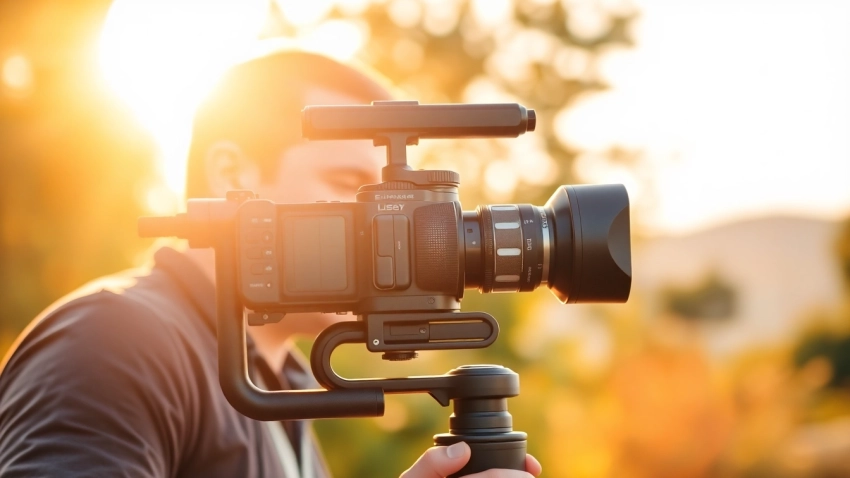
Mastering the Art of Camera Stabilizer: Techniques for Smooth Filming
Understanding Camera Stabilizer Technology
In today’s fast-paced world of videography and photography, smooth, steady shots have become a hallmark of quality content. A Camera Stabilizer serves as an essential tool for achieving that level of professionalism. By using advanced technology and innovative designs, these devices help creators eliminate the shaky footage that can ruin an otherwise captivating scene. In this article, we will explore the intricacies of camera stabilizers, focusing on their components, types, essential setup tips, and effective filming techniques, among other vital insights.
Components and Features of Camera Stabilizers
A well-designed camera stabilizer comprises several critical components that contribute to its functionality. Understanding these components is essential for both novice and experienced users. The primary features include:
- Mounting Plate: Serves as the interface between the camera and the stabilizer, allowing users to quickly attach or detach their equipment.
- Gimbal Mechanism: Often consists of three motorized axes (tilt, pan, roll) that facilitate smooth, controlled movement, compensating for camera shake.
- Battery: Powers the stabilizer’s motors, with some models offering extended usage times for long shoots.
- Control Interface: Enables users to adjust settings, calibrate the gimbal, and switch between modes. This might include joysticks or buttons for manual control.
- Weight System: Helps in balancing the camera by adding or redistributing weight, ensuring optimal stability.
How Camera Stabilizer Works to Eliminate Shaky Footage
The effectiveness of a Camera Stabilizer lies in its operational principles. Most stabilizers use a combination of mechanical balancing and electronic stabilization. Here’s how it works:
- Balancing: Before filming, the camera must be balanced on the stabilizer. Proper balance ensures that the weight is evenly distributed, reducing strain on the motors.
- Motion Detection: Sensors in the gimbal detect any unwanted movements. When the user moves the stabilizer, these sensors help the motors react instantly, compensating for any camera shake.
- Smooth Adjustments: The system adjusts the camera’s orientation in real-time, allowing for quick pans, tilts, and movements while maintaining a level shot.
Types of Camera Stabilizers Available in the Market
The market for camera stabilizers is diverse, catering to various filming styles and preferences. Each type has its merits:
- Gimbals: These are the most popular type of stabilizers, known for their three-axis stabilization. They are perfect for handheld shooting, ensuring smooth footage even during dynamic movement.
- Steadicams: A more traditional option, steadycams allow for fluid camera movement. They rely on a counterweight system, enabling smooth tracking shots.
- Body-Mounted Stabilizers: These devices are worn by the user, distributing weight across the shoulders and back, making them ideal for moving shots and reducing production fatigue.
- Handheld Stabilizers: Lightweight and portable, these stabilizers are best for compact cameras and offer convenience for on-the-go shooting.
Choosing the Right Camera Stabilizer for Your Needs
With an array of camera stabilizers on the market, selecting the right one requires careful consideration. Various factors play into this decision.
Assessing Camera Compatibility with Stabilizers
Before purchasing a camera stabilizer, compatibility with your camera system is essential. Most stabilizers are designed for specific weights and sizes of cameras, so ensure that your equipment meets the stabilizer’s capacity. Here are some elements to assess:
- Weight Limit: Check the maximum weight the stabilizer can support, as exceeding this limit can lead to malfunction.
- Mounting Options: Ensure the stabilizer’s mounting plate fits your camera’s tripod socket.
- Adaptability: Some gimbals come with adjustable mounting plates that allow adaptability to various camera styles.
Factors to Consider When Buying a Camera Stabilizer
Choosing the right stabilizer means assessing a variety of factors, including:
- Budget: High-quality stabilizers can range significantly in price. Establish a budget before shopping to narrow down suitable options.
- Ease of Use: Some stabilizers are equipped with advanced features, making them complex for beginners. If you’re new to stabilization, prioritize user-friendly options.
- Portability: Consider your shooting locations; some stabilizers are more compact and portable than others, making them easier to carry on adventures.
Common Use Cases for Different Camera Stabilizer Types
Each type of stabilizer has its typical use scenarios:
- Gimbals: Commonly used for cinematic productions, travel vlogs, and documentaries due to their versatility.
- Steadicams: Often employed in professional filmmaking for those dramatic, sweeping shots.
- Body-Mounted Stabilizers: Ideal for sports videography, documentary films, and situations where the operator needs mobility.
- Handheld Stabilizers: Best suited for casual shooting and streamers who want real-time, on-the-go filming.
Setting Up Your Camera Stabilizer
Setting up a camera stabilizer correctly can make a significant difference in video quality. Proper setup involves various steps that can sometimes be overlooked.
Essential Tips for Proper Stabilizer Setup
Following these guidelines during setup can enhance stabilization effectiveness:
- Read the Manual: Each stabilizer has unique features and requirements—ensure you understand its specifications before use.
- Balance Your Camera: Balancing the camera before filming is crucial to stabilizer performance. This includes adjusting the gimbal and redistributing weights if necessary.
- Test Settings: If available, run a test on different settings to identify what works best with your stabilizer.
A Step-by-Step Guide to Balancing Your Camera Stabilizer
Here’s a straightforward step-by-step process to balance your stabilizer:
- Mount the Camera: Securely attach your camera to the stabilizer’s mounting plate.
- Adjustment: If your stabilizer has adjustable arms or platforms, modify them to ensure the camera is level.
- Weight Distribution: Use weights or balance rods if provided to distribute the camera’s weight evenly across the stabilizer’s arms.
- Check Movement: Move the stabilizer in various directions—if the camera tilts or falls outside your preferred orientation, adjustments are necessary.
Testing the Stability: Quick Checks Before Filming
Before hitting record, conduct quick stability tests to ensure everything is functioning correctly:
- Listen for Noises: Ensure there are no grinding sounds from the motors, as this could indicate a problem.
- Perform a Shake Test: Gently shake the stabilizer to see how well it maintains its position and stability.
- Movement Fluidity: Check how well the gimbal responds to slight movements. The transitions should be smooth and consistent.
Filming Techniques with a Camera Stabilizer
Understanding how to effectively use a Camera Stabilizer is vital for capturing stunning footage. Mastering filming techniques will elevate your production quality.
Basic Movements and Techniques for Smooth Footage
Whether you’re a beginner or a seasoned filmmaker, mastering simple techniques can significantly improve footage quality:
- Walking Techniques: Maintain a slight bend in the knees and walk slowly. This reduces the vertical bounce, producing a more level shot.
- Turning: Pivot your hips rather than rotating with your shoulders to provide smoother lateral movements.
- Low Shots: For shots close to the ground, bend your knees and bring the stabilizer closer to the ground to capture dynamic perspectives.
Advanced Filming Techniques Using Camera Stabilizers
Once you’re comfortable with basic techniques, consider exploring these advanced strategies to create captivating content:
- Orbit Shots: Circularly move around a subject while keeping it centered in the frame, resulting in a dynamic shot.
- Dolly Zoom: Combine zooming in or out with your movement towards or away from the subject for a dramatic effect.
- Crane Shots: Gradually elevate your stabilizer to create a crane-like movement for a grand sweeping shot.
Common Mistakes to Avoid While Using a Camera Stabilizer
While using a Camera Stabilizer can be intuitive, certain common mistakes can still arise:
- Improper Balancing: Skipping the balancing process can lead to camera shake and gimbal strain.
- Excessive Speed: Rapid movements can result in choppy footage. Instead, aim for smooth, controlled motions.
- Neglecting Settings: Always check your stabilizer settings before filming; a wrong setting can hinder performance.
Varying Styles in Camera Stabilizer Filmmaking
The application of camera stabilizers varies dramatically, showcasing a plethora of creative styles. Exploring these approaches can expand your filming repertoire.
Creative Approaches for Dynamic Shots with Camera Stabilizers
Camera stabilizers open up a range of creative possibilities for filmmakers. Here are some dynamic approaches:
- Storytelling Through Movement: Use the stabilizer to symbolize character development or emotional arcs through movement.
- Incorporating Surroundings: Capture the environment creatively by experimenting with different angles, such as high aerial shots or ground-level perspectives.
- Timelapse with Stabilization: Combine stabilization with time-lapse photography to create visually striking sequences that engage viewers.
Case Studies of Successful Filmmaking with a Camera Stabilizer
Analyzing successful projects that utilized camera stabilizers can provide valuable insights:
- Commercials: Many advertisements use stabilizers to achieve high-quality, polished visuals, showcasing products in motion.
- Documentaries: Documentarians often rely on stabilizers for capturing real-life narratives with fluidity, making the viewing experience seamless.
- Action Films: Directors leverage stabilizers to follow stunt sequences closely, creating suspenseful, immersive action scenes.
Future Trends in Camera Stabilizer Technology and Filmmaking
The landscape of camera stabilization technology continues to evolve. Key trends to watch for include:
- AI Integration: Future stabilizers may integrate artificial intelligence for enhanced motion smoothing and predictive adjustments.
- Increased Portability: Ongoing advancements will likely result in lighter, more compact stabilizers, improving user mobility.
- Augmented Reality (AR): As AR technologies become more prevalent, expect innovations that allow seamless interaction between the real and digital worlds.












Leave a Reply